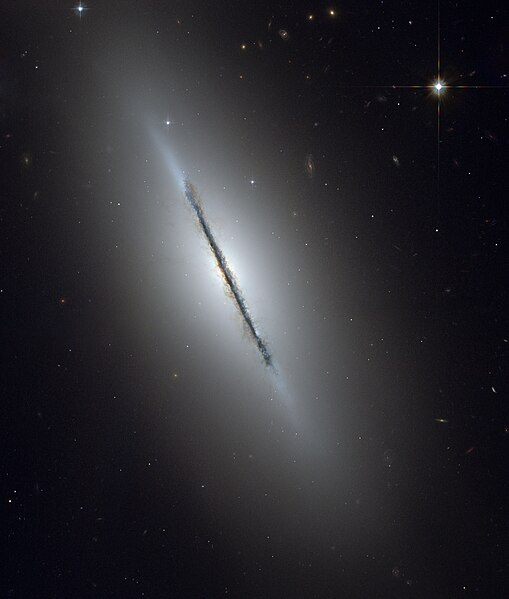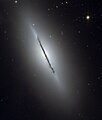Fil:Ngc5866 hst big.jpg
Utsjånad

Storleik på førehandsvising:509 × 599 pikslar.Andre oppløysingar:204 × 240 pikslar|408 × 480 pikslar|652 × 768 pikslar|870 × 1 024 pikslar|1 739 × 2 048 pikslar|3 190 × 3 756 pikslar.
Opphavleg fil(3 190 × 3 756 pikslar, filstorleik: 11,45 MB, MIME-type:image/jpeg)

Følgjande er henta frå filomtalen åt denne fila påWikimedia Commons:
Filhistorikk
Klikk på dato/klokkeslett for å sjå fila slik ho var på det tidspunktet.
| Dato/klokkeslett | Miniatyrbilete | Oppløysing | Brukar | Kommentar | |
|---|---|---|---|---|---|
| gjeldande | 29. juli 2009 kl. 20:07 |  | 3 190 × 3 756(11,45 MB) | Tryphon | Better quality, from http://imgsrc.hubblesite.org/hu/db/images/hs-2006-24-a-full_jpg.jpg. |
| 16. februar 2009 kl. 18:49 |  | 3 190 × 3 756(879 KB) | Spencer | Much higher res | |
| 26. mars 2007 kl. 23:29 |  | 1 280 × 1 507(1,38 MB) | Barfoo2 | == Summary == From original NASA press release::This is a unique view of the disk galaxyNGC 5866tilted nearly edge-on to our line-of-sight.Hubble'ssharp vision reveals a crisp dust lane dividing the galaxy into two hal |
Filbruk
Dei følgjande 21 sidene bruker denne fila:
- Aktiv galaksekjerne
- BL Lacertae-objekt
- Blasar
- Dverggalakse
- Elliptisk galakse
- Galakse
- Galaksehop
- Galaktiske koordinatar
- Irregulær galakse
- Kvasar
- LINER
- Linseforma galakse
- Radiogalakse
- Ringgalakse
- Seyfert-galakse
- Spiralgalakse
- Stavspiralgalakse
- Superhop
- Supermassivt svart hòl
- Vekselverkande galakse
- Mal:Galakse
Global filbruk
Desse andre wikiane nyttar fila:
- Bruk på ast.wikipedia.org
- Bruk på be.wikipedia.org
- Bruk på ca.wikipedia.org
- Bruk på cs.wikipedia.org
- Bruk på de.wikipedia.org
- Bruk på el.wikipedia.org
- Bruk på en.wikipedia.org
- Bruk på en.wikibooks.org
- Bruk på eo.wikipedia.org
- Bruk på es.wikipedia.org
- Bruk på eu.wikipedia.org
- Bruk på fi.wikipedia.org
- Bruk på fr.wikipedia.org
- Dragon (constellation)
- Galaxie
- Utilisateur:Itzcoalt
- Modèle:Utilisateur mystère
- Catégorie:Utilisateur Mystère
- Utilisateur:Patrinet/Galerie Utilisateur
- Utilisateur:Corle1nes
- Utilisateur:Célestin Moreau/Galaxies
- Utilisateur:Nicolas ANCEAU/Bibliothèque
- Utilisateur:Caro L
- Utilisateur:Viatcheslav
- Utilisateur:Silassouille
- Utilisateur:Chappa'ai7
- Utilisatrice:MamzellTopi
- Bruk på he.wikipedia.org
- Bruk på hr.wikipedia.org
- Bruk på hu.wikipedia.org
- Bruk på hy.wikipedia.org
- Bruk på id.wikipedia.org
- Bruk på it.wikipedia.org
- Bruk på ja.wikipedia.org
- Bruk på kk.wikipedia.org
Sjåmeir global brukav denne fila.
